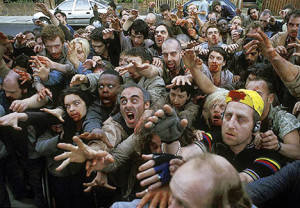Tag Archives: zombie
ZOMBIE OUTBREAK CHINA – Face-Eater Attack in China
AN intoxicated bus driver has been detained after he gnawed on a female driver’s face  after blocking her car on a road in Wenzhou City of Zhejiang Province, local media reported yesterday.
after blocking her car on a road in Wenzhou City of Zhejiang Province, local media reported yesterday.
Police said the incident occurred near a bus station in Ouhai District at 2pm on Tuesday when a man surnamed Dong rushed onto the road and blocked the vehicle of a female driver surnamed Du, Wenzhou City News reported.
The man then climbed on the car’s hood and started hitting the windshield while Du screamed inside, police said.
Several minutes later, Du got out of the car to flee, but the man jumped on her and started gnawing on her face once they were on the ground, police said.
Passers-by said Du’s face was covered in blood. They said they tried to pull Dong off the woman, but he seemed so “crazy” that they couldn’t stop him.
Police stopped the man. Doctors at a nearby hospital said Du will need plastic surgery to repair the damage from the bites on her nose and lips.
Police said Dong had been drinking heavily with his friends at lunch that day.
ZOMBIE OUTBREAK – Are synthetic drugs creating zombies?
Zombies are no longer fictional characters that inhabit our movie screens. They have  become “real” in the eyes of some people thanks to the new synthetic drugs that are young people have discovered.
become “real” in the eyes of some people thanks to the new synthetic drugs that are young people have discovered.
HEADLINE from last week: “Man Eats Family Dog After Police Say He Ingested K-2.” This is not a “National Enquirer” headline. This came directly from the Waco, Texas, ABC TV affiliate.
Witnesses claim Michael Daniel assaulted people at his home, chased a neighbor, and began barking and growling. He then picked up the family dog, strangled it, and then began to eat it, hair, flesh and all. Family members claim Daniel was experiencing a bad trip after ingesting K-2.
This is only two weeks later after the infamous Miami incident, where a man, high on synthetic drugs, chewed off the face of a homeless man along a stretch of busy highway. Since then similar zombie/cannibal incidents have been reported in Manatee County, Florida, Maryland, Louisiana, and now Texas. The Maryland incident involved a man reported a man killing and then eating his roommate’s heart and brain. They all have been attributed to synthetic drugs.
Spice, K-2, potpourri, space, bath salts, etc. are forms of synthetic marijuana that until recently were legal and found in many stores. Essentially they are a mixture of dried herbs and spices mixed with chemicals. These drugs are undetectable by smell or drug testing and are quickly becoming the drug of choice amongst drug users.
Here in Clare County, the health department demanded that retailers take the synthetic drugs off their shelves. This is not the case, however, in other counties. One only has to make the short drive to Bay City where I’m told synthetics are sold at Earth Oddities, Kings and CB Discount.
I’m sure in short order, the sale of synthetics will be banned statewide. However, will that solve the problem? I don’t think so. Because they are readily available, cheap, and provide a quick high, drug users will continue to purchase the drugs illegally.
And that’s a problem. Along with the cannibalistic atrocities, several murders and violent crimes have been attributed to synthetic marijuana. If meth makes people hallucenogenic, synthetics drive some people to violent acts and craziness. It is, say many, the worst drug to come along in a long while.
It’s great that Clare County has prohibited the sale of synthetics. They acted quicker than a lot of counties in this regard. However, as many of us know, a lot of Clare County’s drug problem comes from downstate. Drug users continually run down to buy their drugs off of Detroit area streets to bring them back here to sell and use.
If one is to believe the zombie apocalypse is near- after all it is trending all over the internet, and we all know to believe everything we read on the internet, then we need to do everything we can to eliminate these drugs that make some people want to act like zombies.
More importantly, synthetic drugs, whether they are bath salts, K-2 or whatever, have no business being in the hands of irresponsible drug users. Let’s hope they get a clue, and get off the crap, asap.
ZOMBIE SURVIVAL – How to assemble your zombie response team
More than ever before the issue of possible zombie apocalypse has been on everyone’s minds. There was that face-eating guy, then another guy ate somebody’s brain just weeks later. In Canada (where I’m from) we also had a guy who comitted monstrous, zombie-worthy acts.
The other day, on my way to work I came across a woman sitting on a milk crate. She was surrounded by newspaper clippings about those recent news events and a bunch of hand-written posters that said “ZOMBIE APOCALYPSE COMING. SUN FLARES. AGE OF AQUARIUS.” I was intrigued enough to stop. I said, “What are you selling?” She looked at me, smiled and calmly said, “I’m not selling anything, darling. I’m just preaching. They’re coming.” I looked around for cameras because I am clearly in the movie about zombies… or is this the real thing?
The point is, maybe it’s time to start thinking seriously about how best to prepare for zombie apocalypse and most importantly – who should be on your zombie survival team. I know you’re probably thinking about the kid you used to know who spent his entire childhood studying military strategies and started his own playground army. Or about the guy you knew in high school who could break into that empty warehouse and throw a party complete with foam-making machine and fire-eating acrobats, or maybe the girl who’s was a science whizz in college and patented a biological warfare out of avocado skins. Sure, knock yourself out assembling all those nice people to be on your team, but you’ll still be missing the crucial member: The leader. What you really need is a new parent. No one is better prepared to lead a survival team – just check out the extensive characteristics and training that amount to creating a perfect zombie-resistance fighter like you’ve never seen before.
Physical stamina – Ability to lift extreme weights (toddler, toddler in a stroller) for prolonged periods of time while running through series of obstacles (stairs, taking the stroller on the bus) with only minimal nourishment (eating meals with toddler who demands a variety of dinners or, to be put on a potty or, to climb onto your lap or who simply grabs your food off of the plate and flings it across the room).
Mental stamina – From the Oxford Dictionary of Sports: “The ability to maintain a high level of motivation for long periods despite discomfort and discouragement; a component of endurance.” (Maternity leave?)
Endurance training – For example, prolonged periods of sleep deprivation combined with developing mental stamina (“Why is the cat black?” “Why is the cat a cat?”), with ability to judge quickly in surprising situations (sudden soiled diaper) while continuing to perform at top physical level (making it to daycare, work, playdate on time). This training is also customized for nighttime (“Why is it dark?” “What is night?”).
Excellent strategic planning – For example, tasks to be completed in limited time under duress (work starts at 9 am, daycare is 15 minutes away, it is 8:45, toddler just took all his clothes off for no reason) combined with additional external circumstances (such as sudden rainfall), and conflicting orders from the members of the team (parent #2 remembers important medical appointment at 9:10; there’s only one car).
Judgment – A situation (birthday party for toddlers) with an element of surprise (falling toddler/ a yellow ball that everyone wants to play with despite seven other balls available) that needs immediate resolution (catching toddler/ hiding the yellow ball).
Loyalty – Faithfulness to the team (family) despite extenuating circumstances (family is acting like jerks, everybody is crying, toddler smashed your iPad).
Combat abilities – From Wikipedia: “Combat is a purposeful violent conflict meant to weaken, or establish dominance over the opposition, or to kill the opposition, or drive the opposition away from a location where it is not wanted or needed.” Please note that after five hours of interrupted sleep, three cups of coffee, and I’ve got the power by Snap on repeat and a variety of surprise elements , a parent runs on pure adrenaline. Zombie? Come at me, bro.
GERM OUTBREAK AT CDC – Security lapses found at CDC bioterror lab in Atlanta
A federal bioterror laboratory already under investigation by Congress for safety issues has had repeated incidents of security doors left unlocked to an area where experiments occur with dangerous germs, according to internal agency e-mails obtained by USA TODAY. In one incident, an unauthorized employee was discovered inside a restricted area.
has had repeated incidents of security doors left unlocked to an area where experiments occur with dangerous germs, according to internal agency e-mails obtained by USA TODAY. In one incident, an unauthorized employee was discovered inside a restricted area.
A Centers for Disease Control and Prevention spokesman says the unsecured door incidents in 2010 and 2009 inside its Emerging Infectious Diseases Laboratory in Atlanta were “not an acceptable practice of the agency.” At no time, though, were bioterror organisms such as anthrax at risk of falling into the wrong hands, he said.
“The doors in question here are but one layer of multiple layers of security when it comes to both the animals and the agents that are worked on,” CDC spokesman Tom Skinner said. “The security measures we have in place, without going into detail, make it close to impossible for anyone who doesn’t have approved access to the agents to get their hands on them.”
The e-mails document doors being left unlocked in the building’s high-containment lab block, which includes an animal-holding area and Biosafety Level 3 labs where experiments are done on microbes that can cause serious or potentially fatal diseases and can be spread through the air. Anthrax, monkeypox, dangerous strains of influenza and the SARS virus are examples.
One e-mail by a CDC safety manager describes an unauthorized man discovered in the animal-holding area and multiple doors that were unsecured at the time. Skinner says the man was a CDC scientist but was not immediately able to provide further details about why he was in the restricted area. Skinner said the man was in an outer corridor of the BSL-3 suite of labs.
For safety and security, access to BSL-3 labs is restricted and they are supposed to have special airflow systems designed to help keep organisms inside. Problems with the airflow systems revealed by USA TODAY, including a February incident where air briefly blew out of a lab into a “clean” hallway, prompted the House Energy and Commerce Committee this week to launch a bipartisan investigation into safety issues. The committee is examining whether CDC — which inspects its own labs along with others nationwide that handle bioterror agents — is complying with federal safety requirements at the lab building, also known as CDC Building 18.
E-mails written by CDC Safety and Occupational Health manager Patrick Stockton indicate the lab has had security lapses that Rutgers University biosafety expert Richard Ebright said may be a “major violation” of security standards for labs that work with potential bioterror agents.
In a November 2009 e-mail, Stockton wrote to several CDC officials involved with Building 18’s high-containment laboratory area: “We are continuing to have some difficulties with doors remaining unsecured in the (high-containment lab) area. … If we continue to have issues, we will need to begin looking at individual access rights for these doors.” The particular issue involved expansion sections of the doors, used to accommodate large pieces of equipment. The “through-bolts are not being re-engaged, and the doors are remaining unsecured,” Stockton wrote.
Five months later, the expansion doors continued to be left unlatched and unsecured. According to an April 29, 2010, e-mail to more than a dozen CDC officials involved with the lab building, Stockton wrote that earlier that day “an individual with no access and no escort” was found in the research animal-holding area of the high-containment lab area.
The e-mail continued: “He did not have access and at this point we are not sure how he got there.” Stockton wrote that he talked to program and animal staff and “no one from their programs let this person in.” CDC’s Office of Security and Emergency Preparedness, which is a liaison to the Department of Homeland Security, was investigating, the e-mail said. Homeland Security officials did not respond to questions about the CDC security incidents.
Stockton’s e-mail says that after the incident he and the building’s high-containment lab manager, Anthony Sanchez, walked the entire high-containment block and found two doors unsecured. “This can certainly happen by mistake on occasion but we have addressed this issue in the past and now it seems to be a common failure point. … It is imperative that all doors leading to high containment remain secured,” Stockton wrote.
Stockton and Sanchez didn’t grant interviews. CDC spokesman Skinner said: “Doors being left open by staff is not a standard practice. It’s unacceptable, and our safety office has sent out numerous reminders to staff of the importance of staff practicing good physical security.”
Skinner said he is unaware of any other door security incidents after the one in April 2010. He emphasized that multiple layers of security in the building would have prevented any unauthorized person from accessing germs that hold the potential to be used as bioterror weapons. “The bottom line is, worker safety and the public safety were never compromised,” he said.
Ebright, of Rutgers University, expressed concern about the repeated issues revealed in news reports about Building 18 since the $214 million building opened in 2005, including articles in 2007 about backup generators that failed to keep airflow systems working during a power outage, and in 2008 about a high-containment lab door that the CDC sealed with duct tape after an incident where an airflow system malfunctioned and sent potentially contaminated air into a “clean” corridor.
The “documents you have obtained over the past several years make it clear that there has been a pattern of corner-cutting and negligence at CDC biocontainment facilities —starting with the failure to include provisions for emergency backup power, and encompassing inadequate door seals, improper airflow, jury-rigged repairs, and unsecured access points,” Ebright said.
If the security issues described in Stockton’s 2010 e-mail continue and bioterror agents are being used in that area, Ebright said, “then heads should fall.”
The CDC currently is responsible for inspecting the safety and security of its labs that work with bioterror agents. Skinner said CDC has a 66-year record of operating its labs safely.
The CDC said this week, in the wake of USA TODAY’s reports, that it is considering having its labs’ safety reviewed by an outside agency, such as the U.S. Army Medical Research Institute for Infectious Diseases (USAMRIID).
Biosafety and biosecurity concerns have been the subject of previous congressional concerns. A 2009 report by the U.S. Government Accountability Office, the investigative arm of Congress, examined the potential risks posed by the growing number of high-containment labs doing research on potential bioterror agents. It found that while lab accidents are rare, they do occur, primarily because of human error and systems failures.
It also noted that insiders working in the labs can pose risks, pointing to the Federal Bureau of Investigation‘s allegation that Bruce Ivins, a scientist at USAMRIID in Fort Detrick, Md., was the “sole culprit” in the 2001 anthrax attacks. While he was under investigation in 2008, Ivins died of a drug overdose.
“There are arguably two aspects to insider risk: the motive of the insider and the ability to misuse material and laboratory facilities,” the GAO wrote in its report.
MIAMI ZOMBIE – No Bath Salts, Only Marijuana Found In Face-Eater Toxicology Tests
According to a full toxicology report released Wednesday afternoon by the Miami-Dade medical examiner, the only drug detected in the lifeless body of infamous Miami face-chewer Rudy Eugene was marijuana.
“The department’s toxicology laboratory has identified the active components of marijuana,” the medical examiner said in a statement, according to NBC Miami. “The laboratory has tested for but not detected any other street drugs, alcohol or prescription drugs…This includes cocaine, LSD, amphetamines (Extasy, Meth and others), phencyclidine (PCP or Angel Dust), heroin, oxycodone, Xanax, synthetic marijuana (Spice), and many other similar compounds.”
CBS Miami reports that the medical examiner’s office sought the assistance of an “outside forensic toxicology reference laboratory” to help confirm the absence of common ingredients of bath salts, a synthetic amphetamine cocktail blamed inseveral recent incidents that bear some similarity to Eugene’s attack.
“Within the limits of current technology by both laboratories,” stated a press release from Medical Examiner Dr. Bruce Hyma, “marijuana is the only drug identified in the body of Mr. Rudy Eugene.”
The report did not address previously reported autopsy findings of what appeared to be undigested pills in Eugene’s stomach, according to the Miami Herald, and an expert told the Associate Press marijuana alone was not likely to cause such an attack.
“The problem today is that there is an almost an infinite number of chemical substances out there that can trigger unusual behavior,” said Dr. Bruce Goldberger, Professor and Director of Toxicology at the University of Florida.Goldberger said that the medical examiner’s office in Miami is known for doing thorough work and that he’s confident they and the independent lab covered as much ground as possible. But it’s nearly impossible for toxicology testing to keep pace with new formulations of synthetic drugs.
“There are many of these synthetic drugs that we currently don’t have the methodology to test on, and that is not the fault of the toxicology lab. The challenge today for the toxicology lab is to stay on top of these new chemicals and develop methodologies for them, but it’s very difficult and very expensive.” Goldberger said. “There is no one test or combination of tests that can detect every possible substance out there.”
The medical examiner’s office did not immediately respond to requests for comment.
Eugene, 31, was widely speculated to have been on some form of synthetic drugs or suffering a drug-induced psychosis the afternoon of May 26 when he stripped naked and brutally attacked homeless resident Ronald Poppo in broad daylight along Miami’s busy MacArthur Causeway, chewing and ripping off roughly half of the older man’s face.
A police officer responding to multiple 911 calls shot and killed Eugene as he crouched over Poppo, reportedly refusing to stop the gruesome assault by growling at the officer with Poppo’s flesh in his mouth.
The 18-minute attack and its aftermath were captured on surveillance video from the Miami Herald’s parking garage, but it is still unknown what prompted Eugene to commit such a horrific crime.
According to Local10, the former North Miami Beach High School football player was once diagnosed as schizophrenic after an arrest, but authorities are not sure if he ever sought treatment.
Records show Eugene had been arrested 8 times since the age of 16, including 4 instances involving marijuana. But though he was once accused of threatening to kill his mother, friends and family members alike say they never expected such violence from Eugene, who was participating in a Bible study, reading the Koran, and telling friends he wanted to stop smoking marijuana.
“There’s no answer for it, not really,” Eugene’s younger brother, Marckenson Charles, told the AP. “Anybody who knew him knows this wasn’t the person we knew him to be. Whatever triggered him, there is no answer for this.”
Poppo, meanwhile, is doing “well,” according to doctors at Jackson Memorial Hospital’s Ryder Trauma Center. The 65-year-old has lost one eye, is missing his nose, and faces a string of surgeries to repair his wounds and reconstruct his face.
“We have mental health professionals to help him with the coping, and he’s coping remarkably well,” said plastic surgeon Dr. Wrood Kassira.
This is a developing story.

